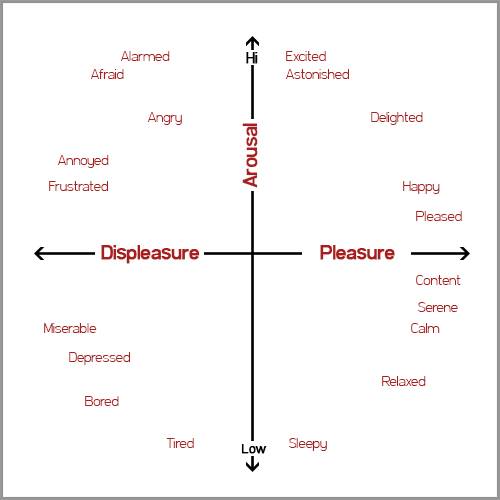Everyone has a different opinion in the fitness arena. While that may be nothing new, it seems as though many fitness professionals are not willing to tolerate any opinion other than one that is valid to them. Some of the reactions people post in regards to online articles can be downright ugly, to the point that people have to take down their blogs altogether.
But the reality is that everyone has a different fitness regimen, everyone has an opinion (and a right to one), and sometimes our emotions can cloud our judgment. In fact, that is what I want to take a look at today – the science behind how our emotions impact the critiques we write in response to articles. My goal is never to upset anyone, but as Patrick McCarty mentioned in a recent article, if no one ever criticizes, how will things grow for the better?
The Science Behind Human Emotion
Human emotions are complex, but humans usually respond to situations based off the emotions they feel at the time. Two major emotions that typically drive us to write mean comments are disgust and anger. There are two structures in the brain involved with the feeling of disgust and those are the insula and basal ganglia. As far as anger, the perception of anger involves a neurotransmitter system (activated by dopamine) and a neural structure, specifically the ventral striatum.
There are also two different models to understand when it comes to emotions and our response to them. These are the Circumplex Model and the Approach-Withdrawal Distinction.
The Circumplex Model
 Before diving headfirst into this model, we need to understand the concepts of arousal and valence. Arousal is the term for the bodily changes that occur with emotion, such as changes in heart rate, sweating, and the release of stress hormones in response to a stimulus (i.e. maybe something you read that really pisses you off). Valence is the subjective quality, positive or negative, of the emotional response to a specific object or event. For example, you read an article and you begin to feel that it is extremely unpleasant.
Before diving headfirst into this model, we need to understand the concepts of arousal and valence. Arousal is the term for the bodily changes that occur with emotion, such as changes in heart rate, sweating, and the release of stress hormones in response to a stimulus (i.e. maybe something you read that really pisses you off). Valence is the subjective quality, positive or negative, of the emotional response to a specific object or event. For example, you read an article and you begin to feel that it is extremely unpleasant.
Both of these dimensions can be put on a scale. This model puts arousal on one axis and valence on another. Arousal is the strength of response to a stimulus and activation to the stimulus. Valence reflects the degree to which the experience is pleasant or unpleasant. Using two dimensions of emotional experience, the circumplex model creates a graphic framework in which a range of emotional states can be positioned.
The Approach-Withdrawal Distinction
Emotion may be classified in terms of motivation, which can be conceptualized as the propensity to action. The propensity to action is a component of some emotional responses. Scientists can test this by using EEGs and giving subjects a PANAS Score (Positive and Negative Affect Score).
Investigators found that people varied in relative level of activity in the anterior left and right cerebral hemisphere when at rest. Investigators linked this asymmetry to the various dispositions of their subjects. People who rated higher on a series of positive affective traits such as enthusiasm, pride, and attentiveness showed relatively greater EEG activity over the left anterior frontal region at rest. Those who were higher on the negative affective traits such as guilt, anger, fear, and disgust showed relatively greater EEG activity over the right anterior frontal region.
So what does all of this brain information mean? It is providing proof that our brain reacts to the emotions we may be feeling at any given time, so if we feel an article evokes disgust or anger in our emotional capacity, you will have withdrawal emotions, which leads to a relatively low PANAS score (meaning negative affect traits), but the part of the brain that will have the most activity (i.e. your EEG) will be the right anterior frontal region.
In a nutshell, different emotions lead to different goals for action. This model characterizes the component of an emotional reaction that is the propensity to action, that is either a tendency to approach the object, event, or situation or to withdraw from it.
Putting These Models Together
 Negative emotions like anger and dislike can lead to avoidance or withdrawal behaviors, which can increase your level of arousal depending on the emotion. Articles that speak against what you believe in may evoke a response like anger and disgust. Most of us will have a stimulus or arousal that then increases the likelihood to respond with a hostile comment. But sometimes it may be best to wait to respond until we can find a way to share our thoughts without attacking the writer. When we do it this way, our comment will sound more relevant and will open up a better discussion platform for others to join into the conversation.
Negative emotions like anger and dislike can lead to avoidance or withdrawal behaviors, which can increase your level of arousal depending on the emotion. Articles that speak against what you believe in may evoke a response like anger and disgust. Most of us will have a stimulus or arousal that then increases the likelihood to respond with a hostile comment. But sometimes it may be best to wait to respond until we can find a way to share our thoughts without attacking the writer. When we do it this way, our comment will sound more relevant and will open up a better discussion platform for others to join into the conversation.
Read the Publication and Understand the Content
I know sometimes when something is totally against what we believe in, it can be hard to read the entire publication. But if you do read through the piece you may find a place where you and the writer have common ground and this can help you in your response. For example, if I read something that says part of building the handstand push up is to start learning the kip, of course this is something I do not agree with, but if the author has other valid points, then I have found common ground with them. I can build a response back to the writer, using common ground first, and then showing the author where I found that it might be better for the athlete to have the baseline strength first in the movement.
Another example is when an author might make a joke in the beginning of his or her article that may be at the expense of another area of fitness, but with further reading you realize the author is saying something that is not against that given area at all. This is why you want to understand the full content before responding. It could turn out to be a situation in which you have 100% commonality.
But even if you and the writer do not agree at all, it’s important to understand what the author is trying to convey to the audience. The more you understand, the less likely you are to bring your arousal emotions into the picture, which means you are less likely to write a hostile response at the author’s expense and the more likely you are to stay in a productive mindset.
You Represent Your Area of Fitness, Whether You Know It Or Not
 You must understand that whatever your area of fitness is, whether it is CrossFit, strongman, powerlifting, kettlebells, or even Jazzercise, you are essentially a representation of that said area. People will read your comments and imagine that’s what your area of fitness is actually like. You can turn people away because of your comment, or you can bring people to understanding.
You must understand that whatever your area of fitness is, whether it is CrossFit, strongman, powerlifting, kettlebells, or even Jazzercise, you are essentially a representation of that said area. People will read your comments and imagine that’s what your area of fitness is actually like. You can turn people away because of your comment, or you can bring people to understanding.
If you post things like, “Yeah, that guys a fucking newb to (insert fitness program here). He doesn’t understand what the hell he’s talking about,” then you trash your own image. It’s better to write in a calm manner, without attacking the writer, and having information to back your comment. When you write in this way, you will have more validity to your statement. You will have the opportunity to open up meaningful discussions that may changes minds, including the author’s. You also open a door to what your fitness community is about. If you write in an attacking manner, you encourage any misconceptions people may have about your area of fitness.
Everyone is going to have an opinion. It may not be your own opinion, but that is okay. But remember your comments are more than just a comment, and you may be representing more than just yourself. Be careful about what you write, and remember to comment only in context to the writing itself, not in hostility to the author. Happy commenting!
References:
1. Barker, Lewis. Psychology. (New Jersey: Pearson Education), 172-175
2. Kosslyn, Stephen M and Smith, Edward E. Cognitive Psychology: the Mind and Brain. (New Jersey: Pearson Education), 329-332
Photos 1 & 3 courtesy of Shutterstock.
Circumplex Model courtesy of Pulse Beat Fit.
Illustration courtesy of xkcd.






